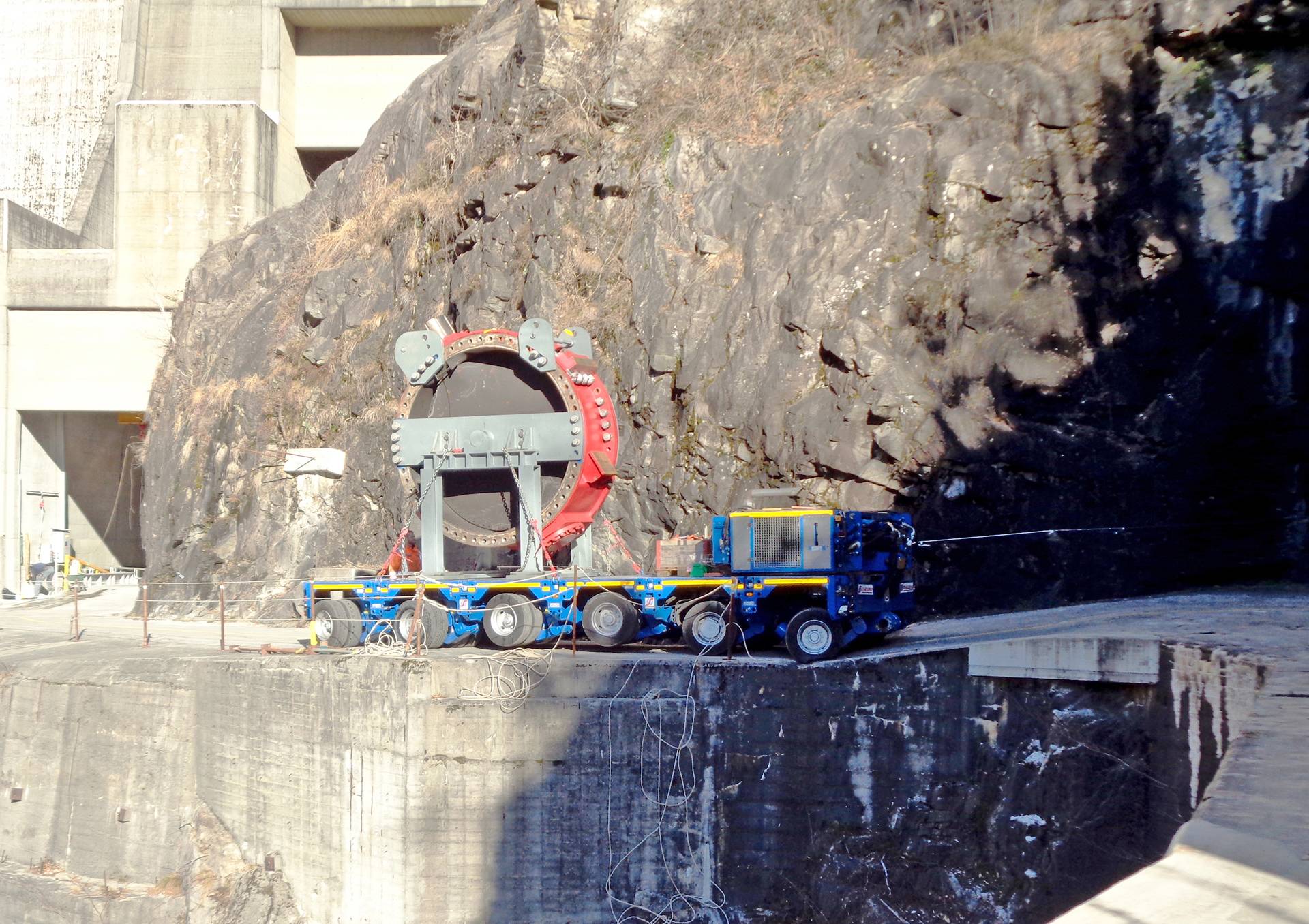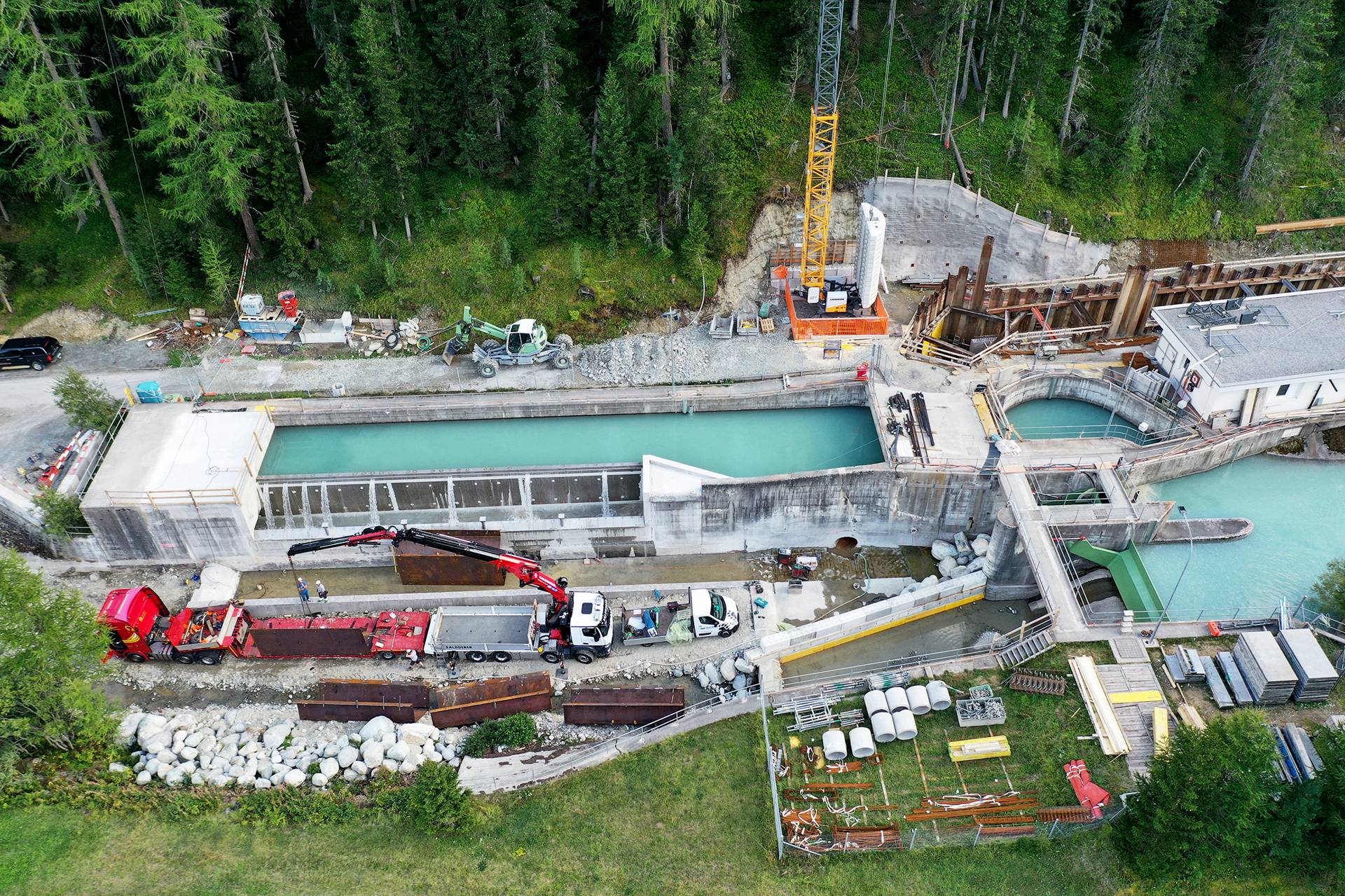Successful premiere for Tyrolean hydropower containers in the Middle East7 min read
Lesedauer: 5 MinutenThe hydropower allrounder Geppert has successfully concluded a further project in the Middle East, this time in the form of five small-scale power plants, each pre-assembled in its own container for use in the drinking water supply of the Iranian city of Semnan.
Counting from the receipt of the order confirmation in March 2018 to acceptance by the customer at the end of June, the ready for connection turbine sets including generators and hydraulic units had to be designed and manufactured from scratch within a period of less than four months. These container-mounted plug and play solutions (a first for Geppert) represented a challenge for the company, not least because of the very tight schedule. Electric power is generated by five ultra-compact Pelton turbines with vertical shafts, some equipped with 5 nozzles and others with 4. These powerful small-scale power plants combine to generate a bottleneck capacity of more than 3 MW, all of which the operators feed directly into the public grid throughout the year. The containers were rapidly connected and commissioned on schedule after their arrival on site. Geppert now plans to expand sales of this versatile and inexpensive container system in the future.
The Tyrolean turbine manufacturer had already supplied a turn-key system for drinking water power generation back in 2017 to Roshd Sanat, an Iranian Group active in the fields of energy, construction and manufacturing industry. A power plant with a Francis spiral turbine with a bottleneck capacity of just under 3.5 MW was constructed in the existing drinking water pipeline close to Qom, a city with a million inhabitants in the north of the country. The Ruzieh project (named after the Ruzieh Springs drinking water source and constructed in record time) was also planned to take advantage of the previously untapped energy potential of an existing drinking water pipeline to generate electricity. Unlike the Qom power plant, this project, located close to the city of Semnan about a further 270 km to the north-east, included the simultaneous manufacture of five turbine units pre-installed in containers. In a contract concluded between Roshd Sanat and the Semnan water supply utility, these hydropower containers were to be installed in several different locations along a primary drinking water pipeline.
Order with a tight schedule
The plan was to install each of the containers next to existing intermediate reservoirs for the drinking water pipeline. The highest power plant, called “Station 1” was located 2,146 m above sea level, while the lowest one was at a height of 1,316 m. All the turbine sets except for Station 4, where the customer had installed a pump turbine, were supplied by Geppert. Looking back over the contract, Geppert’s Project Manager, Ulrich Ruggenthaler, recalled that the schedule represented the greatest challenge. “As a result of the customer’s delivery requirement of the end of June, we had less than four months to complete the design, manufacture and pre-assembly after receiving the order in March 2018. It was also the first time for us that the turbine sets had to be constructed inside containers.” Ruggenthaler added that as their suppliers had full order books the on-time supply of bought-in components such as generators and hydraulic equipment could not be taken for granted.
Compact equipment installed in containers
A number of key conditions had to be met when constructing the hydropower units in containers originally intended to transport goods. The turbine cases, which could not be made with the usual ring mains because of the lack of space, had to be manufactured as ultra-compact units. Computer-supported flow analyses completed before manufacture commenced confirmed that optimal functionality and efficiency levels could be achieved even with the constricted turbine cases. The design which was selected also enabled each of the five turbines to have an identical case, the modifications for the individual turbines being limited in the main to components such as nozzle needles or the corresponding orifices. Turbine components in contact with the water such as the Pelton rotors which were machined from monoblocks were all completely manufactured from food quality-certified stainless steel. The turbine sets were constructed on rigid frames so that they could be in an optimal position to resist the forces induced during operation. A special structure was also fabricated for installing the base plate. During installation on site the assembly frames and the floor structure of the containers were embedded in concrete foundations. The designers also devoted particular attention to the exchange of air and heat dispersion inside the metal containers. This was achieved by fitting all generators with their own exhaust air shafts which conveyed the hot air from the generator directly into the open air. Two separate ventilation slots in the container walls supplied fresh air to evaporate the condensate which inevitably formed on the turbine cases.
Bottleneck capacity up to 745 kW
Except for the number of nozzles (two turbines were supplied with 5 nozzles and three turbines with 4) the machines were to all intents and purposes identical in construction. Because of the cramped conditions inside the containers the designers had opted for a space-saving hydraulic/mechanical combination to control the nozzles. The nozzle needles are precisely controlled by a hydraulic cylinder acting on a rigid rod. The cylinder is connected to a hydraulic system also housed in the container and controls the plant’s deflectors and the emergency shut-off valves at the same time. Each turbine has a nominal discharge of 500 l/s for power generation at its disposal, with the usable heads varying between 147 and 189 m. The turbines with 5 nozzles rotate at 750 rpm and the ones with 4 heads rotate at 1000 rpm. At peak water availability the turbines generate bottleneck capacities between 499 kW and 745 kW. Five vertical synchronous generators are coupled directly to the turbine shafts and act as energy converters. The generators rotate at exactly the same speed as the turbines and each was manufactured with a connection voltage of 400 V. The generators coupled with the turbines with 5 nozzles achieve a rated apparent power of 560 kVA each, and two of the generators powered by the turbines with 4 nozzles achieve 800 kVA while the third generates 630 kVA. The technical equipment inside the containers is supplemented by the hydraulic units. The turbine control systems, low tension equipment and transformers are accommodated in separate buildings.
Problem-free installation
After acceptance of the hydropower containers by the client in the factory, delivery to site was completed in July 2018 as agreed in the contract. The “Made in Tyrol” hydropower containers were delivered to the Middle East in an overland journey of several thousand kilometres. Their arrival in Semnan was delayed for several days by complications experienced during customs clearance. According to Project Manager Ruggenthaler who supervised the installation and commissioning on site between the end of August and the beginning of September, the container design proved to be extremely practical. “Unlike a large machine hall with several different pieces of equipment, the hydropower containers constitute just a single unit which has to be watched during installation. The result was that it was possible to complete the installation, which needed up to 40 persons at the same time, within a very short period. All the units had started work when I left on 7th September.”
The container solution has a future
As in the Qom drinking water power plant, the turbine control units and all the control engineering equipment for the Ruzieh project were manufactures by Pro Integris, a Croatian company specialising in the automation of hydropower plants. The controls for the plants are based on a SCADA system and enable the stations to be operated either manually or completely automatically. “The challenge for the control system was that both the power generation of the hydropower plants and the supply of drinking water had to be maintained without interruption. As a matter of principle, of course, the drinking water supply took precedence with the result that only the amount of water permitted by the water levels in the various reservoirs could be used for power generation. If any of the individual stations had to come to a complete standstill, the relevant bypass systems spring into action in a second, thus guaranteeing the drinking water supply every time. An on-line connection makes the remote monitoring and control of the power plants possible, and the control panels installed in the secondary buildings also enable the equipment to be controlled on site. Because of the good experience with the Ruzieh project, Geppert is very confident about the future of the hydropower containers. The turbine manufacturers are convinced that the low-cost power generation units can be used in increasing numbers to supply remote regions with electricity.
Share:


